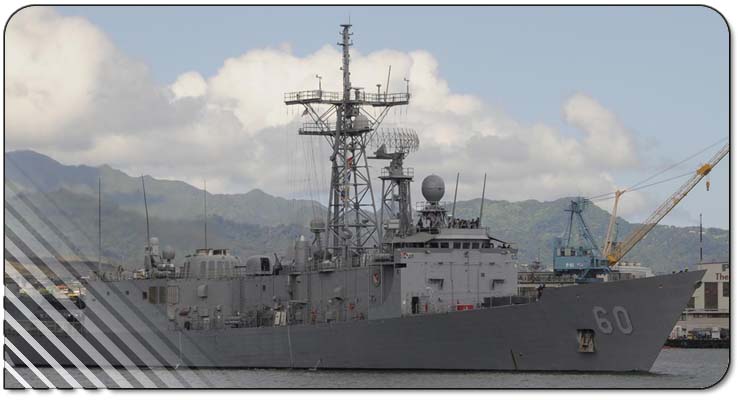FFG 60 | USS RODNEY M. DAVIS

Namesake:Sergeant Rodney Maxwell Davis
|
||||||||||||||||||||||
Historical Notes:USS Rodney M. Davis (FFG-60), an Oliver Hazard Perry-class frigate, is a ship of the United States Navy named for Marine Sergeant Rodney M. Davis (1942–1967), who was posthumously awarded the Medal of Honor for his heroism in the Vietnam War. Rodney M. Davis was laid down on 28 October 1982 by the Todd Pacific Shipyards Co., Los Angeles Division, San Pedro, Ca.; launched on 11 January 1986; and commissioned on 9 May 1987. The ship was homeported at Yokosuka, Japan for several years while assigned to Destroyer Squadron 15. As of 2005, Rodney M. Davis is home ported at NS Everett, Washington, and assigned to Destroyer Squadron 9. History: On 28 April 2001 a LEDET assigned to the Rodney M. Davis, with later assistance from the US Coast Guard Cutter Active (based in Port Angeles, WA) made the largest cocaine seizure in maritime history when they boarded and seized the Belizean F/V Svesda Maru 1,500 miles south of San Diego. The fishing vessel was carrying 26,931 pounds of cocaine. In the summer of 2005, Davis participated in the 11th annual Cooperation Afloat Readiness and Training (CARAT) exercise. CARAT is an annual series of bilateral military training exercises designed to enhance cooperative working partnerships with several Southeast Asian nations. Ensuring freedom of the seas by increasing maritime security efforts in the region is a primary focus of the CARAT series. In the summer of 2006, with the help of the crew from the Rodney M. Davis, 11 tons of creosote logs were removed from the beaches of NAVMAG Indian Island. The project was completed with no labor cost, due to the support of the Davis crew on this shoreline enhancement project. Removal of creosote contaminant source from the beaches enhances shoreline habitat and marine water quality. 2006-2007 Deployment Davis departed Naval Station (NAVSTA) Everett for a deployment to the Southern Pacific Nov. 28, 2006. On March 3, 2007, Sailors from Davis participated in two community relations (COMREL) projects during the ship’s visit to Panama in February. The Davis Sailors' COMREL efforts included visits to local orphanages and maintenance/improvements at a library in the Cinco de Mayo district of the city. Sailors spent their day cleaning, repairing, and painting chairs and cabinets at the Eusebio Morales Library. Five more Davis sailors visited a local orphanage, Hogar Divino Nino, to spend time with infants and toddler orphans to give them some much needed human contact. The Davis sailors took diapers, formula, baby wipes and other child care supplies to aid the staff at the orphanage. The two groups reassembled at another orphanage, Nutre Hogar, to hand out Spanish-language Disney movies to the children, which were part of a generous donation made through the Jacksonville, Fla., area office of the United Service Organizations (USO). Davis completed her transit of the Panama Canal on March 25, 2007 from the Caribbean Sea to the Pacific Ocean. The Sailors of Davis completed their third community relations (COMEL) project in Panama City, Panama on April 3, 2007. During the ship’s three-day port visit, 21 members of the crew spent a day helping to improve Hogar Nuevo Pacto, a home for abused children in Panama City. The crew raised $1,100 in donations to pay for supplies and improvements for the home. Davis sailors bought equipment to repaint the inside of the house, as well as groceries, new shower curtains, bed sheets, and light fixtures for the children’s living areas. The home, previously U.S. military housing, was greatly in need of some modernization and assistance from able hands. Despite rainy weather outside, the crew spent the day productively inside, painting hallways and bedrooms, installing conveniences like toilet paper dispensers and toothbrush holders in the bathrooms, and replacing lights and correcting electrical safety problems. On the evening of April 19, 2007, Davis intercepted the fishing vessel Mariana de Jesus in international waters. The 33-foot vessel was overcrowded with 31 migrants. Davis gave the migrants food and water and they were all examined by the ship's medical personnel. Some were treated for mild dehydration and headaches, but overall they were found to be in good physical condition. The migrants were then transferred to the El Salvadorian Navy. On April 23, 2007, the Costa Rican Coast Guard vessel Juan Rafael Mora (JRM) and Davis intercepted the fishing vessel Kuerubin with 61 Chinese migrants, all of whom were transferred to the JRM. Davis was tasked to ensure their health and safety was maintained by providing food, water, and medical supplies. All were malnourished and dehydrated for they had been without food or water for four days. The frigate returned to Everett naval base on June 12, 2007 after a six-month deployment in the war on drugs. The first maritime seizure of liquid cocaine occurred April 25 when the Davis located the fishing vessel Emperador from Ecuador in the Eastern Pacific. A Coast Guard law enforcement team boarded the Emperador and located 3,850 gallons of liquid cocaine. Each gallon of the liquid is the equivalent of 1.3 kilograms of processed cocaine. The Coast Guard boarding team detained the 17 crewmembers of the vessel. Sixteen of the crewmembers were from Ecuador, and one of the crewmembers was Colombian. The Coast Guard boarding team and crew of the Davis transported the vessel to Guayaquil, Ecuador , for further examination by officials from the Drug Enforcement Administration and Ecuadorian authorities. The majority of the liquid cocaine, 3,600 gallons, was turned over to Ecuadorian authorities for destruction. |
||||||||||||||||||||||
Ship's Crest:
|
||||||||||||||||||||||
PHOTOS
|


 Seal:The
complete coat of arms as described above, on a white field enclosed by
a dark blue border edged on the outside with a continuous gold rope and
inscribed in gold with the words USS RODNEY M. DAVIS at the top and FFG
60 below.
Seal:The
complete coat of arms as described above, on a white field enclosed by
a dark blue border edged on the outside with a continuous gold rope and
inscribed in gold with the words USS RODNEY M. DAVIS at the top and FFG
60 below.


















